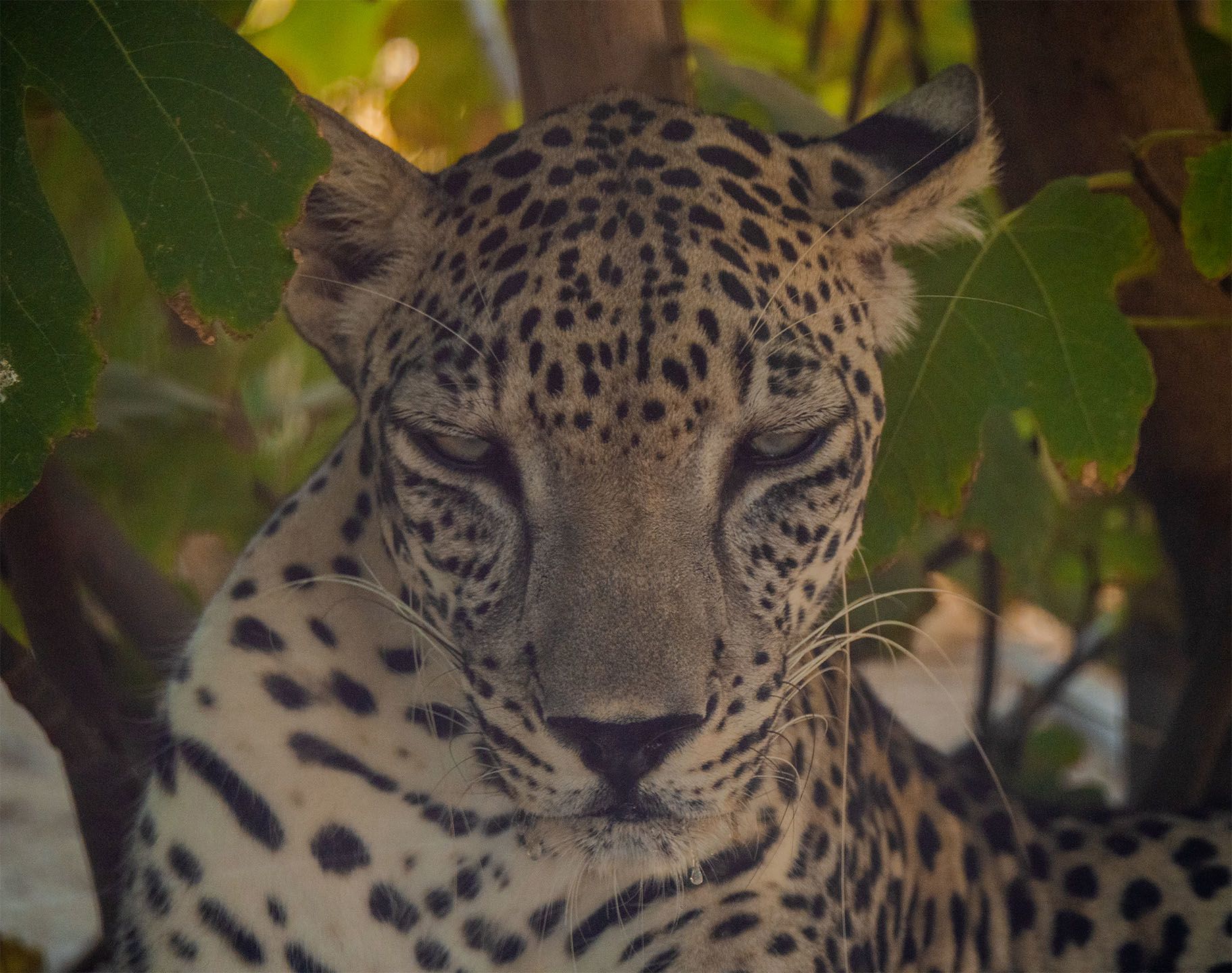Rewilding Arabia
Return of the leopard is at the heart of plans to conserve and regenerate Saudi Arabia’s landscapes and wildlife

It is one of the most beautiful, mysterious and symbolic animals ever to have graced the wild landscapes of Saudi Arabia, which it has done since time immemorial.
But the Arabian Leopard is also classified by the International Union for Conservation of Nature as “critically endangered” – one step away from extinction in the wild.
Fewer than 200 are believed to exist throughout the Arabian Peninsula, with the largest confirmed surviving population found in Oman’s Dhofar Mountains.
In Saudi Arabia, the animal is feared to be all but extinct, driven to the edge by centuries of uncontrolled hunting, of both itself and its prey, and by the steady loss of suitable habitats as human development has expanded.
All that is beginning to change, however, thanks to a world-leading captive-breeding program that will return the magnificent animal to the wild.
So far, the Wildlife Research Center in Taif has successfully bred 16 leopards as part of an Arabian Leopard Program being managed by the Royal Commission for AlUla (RCU). The most recent birth of a cub was in April 2021.
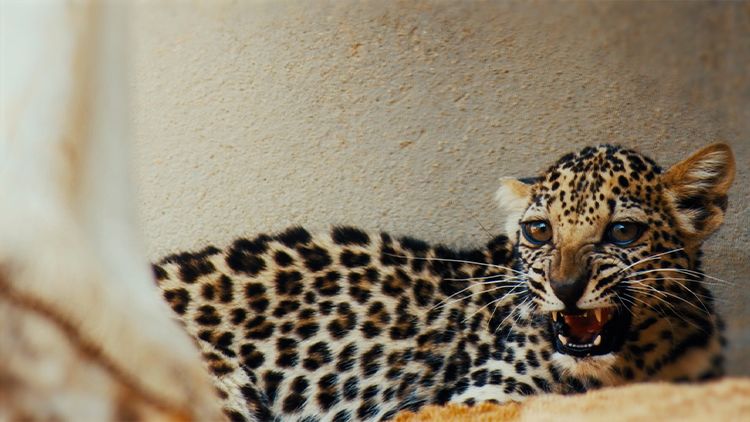
The birth of this cub in April 2021, pictured here at five months of age, is the latest success in the Arabian Leopard Program. (RCU)
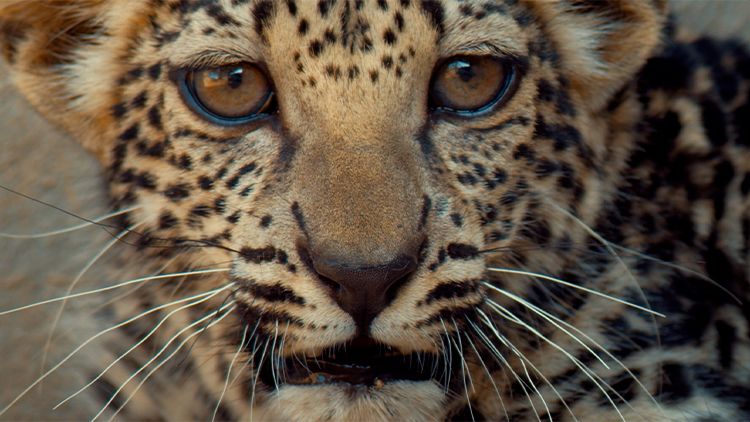
The birth of this cub in April 2021, pictured here at five months of age, is the latest success in the Arabian Leopard Program. (RCU)
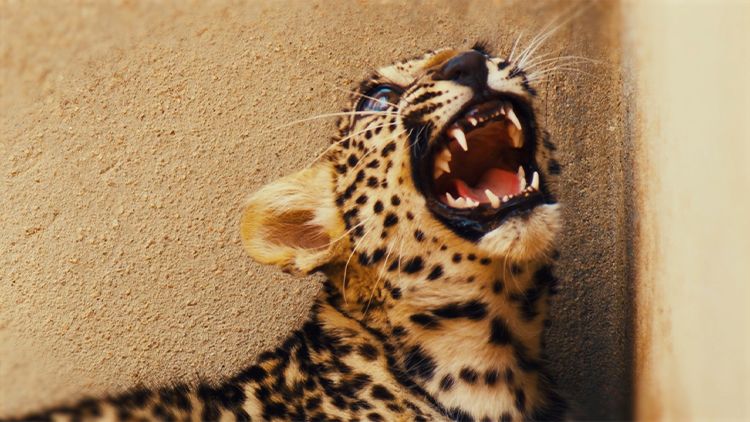
The birth of this cub in April 2021, pictured here at five months of age, is the latest success in the Arabian Leopard Program. (RCU)
The ultimate aim of the RCU through its program is to improve the Arabian leopard’s status on the IUCN Red List of Threatened Species. To that end it is working in partnership with Panthera, a global conservation organization dedicated to preserving the world’s seven big wild cat species and the critical role they play in global ecosystems.
Eventually, the leopards will be released into the Sharaan Nature Reserve, which is being created by the RCU in the dramatic canyon landscapes east of the ancient rock-carved Nabateaen city of Hegra, an area that was the animal’s natural habitat for millennia.
“We believe that saving endangered species such as the Arabian leopard is critical to the protection of our planet and the natural balance of our ecosystem,” said Ahmed Mohammed Al-Malki, RCU’s director general of nature reserves.
“Our goal at RCU is nothing less than to restore the power of nature's balance.”
In February 2022 that commitment was acknowledged when the RCU was awarded government-membership status by the IUCN – an honor normally granted at state level, but extended to the organization “in recognition of its commitment to conservation.”
The announcement, said Amr AlMadani, CEO of the RCU, “demonstrates the increasing international recognition that RCU, undertaking a project of immense scale, is a key player in global conservation.”
RCU will now be able not only to draw upon the specialist knowledge of 18,000 IUCN experts, but also to share the results of its work in AlUla with a global audience of conservationists.
Dr Bruno Oberle, IUCN Director General, said RCU’s membership “will enhance IUCN’s presence in the region, and further strengthen the Union’s capacity to promote the good governance of the world’s natural resources and environment”.
The leopard program is a flagship of a raft of green initiatives designed to restore and protect the balance of nature across the Kingdom. They build on previous successes, including the reintroduction of other threatened species and the designation of great swaths of the country as protected areas.
As part of the Saudi Green Initiative, announced in March 2021, rewilding initiatives are under way across the Kingdom, including the reversal of desertification across vast areas, the restoration of habitats degraded by livestock overgrazing, and a huge planned increase in the number and scale of protected areas.
The first protected conservation area in Saudi Arabia was established in 1986: a 13,775 square kilometer reserve at Harrat Al-Harrah in the north of the Kingdom. Now it is home to a dazzling array of important animals, including the reem gazelle, Arabian wolf, red fox, sand fox, striped hyena, Cape hare, jerboa, houbara bustard and golden eagle.
Since the designation of Harrat Al-Harrah, 14 areas, totaling more than 82,000 sq km, have been awarded protected status. Under the auspices of the SGI, there are now plans to increase the area of protected land to about 600,000 sq km — more than 30 percent of the Kingdom’s total territory.

The birth of this cub in April 2021, pictured here at five months of age, is the latest success in the Arabian Leopard Program. (RCU)
The birth of this cub in April 2021, pictured here at five months of age, is the latest success in the Arabian Leopard Program. (RCU)

The birth of this cub in April 2021, pictured here at five months of age, is the latest success in the Arabian Leopard Program. (RCU)
The birth of this cub in April 2021, pictured here at five months of age, is the latest success in the Arabian Leopard Program. (RCU)

The birth of this cub in April 2021, pictured here at five months of age, is the latest success in the Arabian Leopard Program. (RCU)
The birth of this cub in April 2021, pictured here at five months of age, is the latest success in the Arabian Leopard Program. (RCU)
The plans set out under the Saudi Green Initiative also include the planting of 10 billion trees over the coming decades, resulting in a 12-fold increase in tree cover, equivalent to rehabilitating about 40 million hectares of degraded land.

"Forging a greener world" – Saudi Crown Prince Mohammed bin Salman at the launch of the Saudi Green Initiative in Riyadh in October 2021. (AFP/Saudi Royal Palace)
As Crown Prince Mohammed bin Salman said when he announced the initiative and its companion Middle East Green Initiative, this literal greening of the country will play a vital role in plans to “chart a path for the Kingdom of Saudi Arabia and the region in protecting the planet, by clearly defining an ambitious road map that rallies the region and significantly contributes to achieving global targets in confronting climate change.”
As a leading global oil producer, he added, “the Kingdom fully recognizes its share of responsibility in advancing the fight against the climate crisis. Just as the Kingdom underpinned energy markets during the oil and gas era, it is going to become a global leader in forging a greener world.”
In that greener world, the Arabian leopard and other revived and protected native species will once again roam free.
The most recent evidence of the success of the Saudi leopard-breeding program arrived on April 23, 2021, in the adorable form of a female cub, the latest to be born at the Prince Saud Al-Faisal Wildlife Research Center in Taif.
The birth, said Al-Malki, “is significant because it is one step further toward reviving the Arabian leopard.”
Staff at the center were excited and relieved when the healthy cub arrived.
“I cannot describe my feelings when she was born,” said Abdulaziz Alenzy, the RCU’s veterinary manager. “We were expecting a cub to be born that day but when I got the call from the keepers, it was: ‘Wow.’ I got up, got dressed and rushed to work.”
There are currently 16 leopards at the center “and we hope to increase the number by between 20 and 50 percent in the next two years,” said Alenzy.
The breeding process, he added, is not easy. “When you introduce pairs to each other, sometimes they will fight and hurt each other, so we have to separate them and repeat the process,” he said.
When the team is sure a leopard is pregnant, she is assigned a specific keeper who is responsible for monitoring her health, behavior and diet constantly until she delivers. The gestation period is between 95 and 100 days, and a leopard typically gives birth to between one and three cubs.
“The first 12 weeks are very critical in any cub’s life, so we try to avoid disturbing them and the mother, and leave her to take care of the cub,” said Alenzy.
In the 13th week, the team carried out a medical examination of the new arrival, confirmed its gender and began a course of immunizations.
“We were blessed with a female cub, which is a great thing for our program,” Alenzy said. “The cub’s general health was excellent, and her mother’s as well.”
Thomas Kaplan, the founder of Panthera, said the birth of the cub was “a moment of absolute, sheer joy.”
He added: “The news gave us the ability to transmit something which is key to every strategy, and that’s hope.
“When you see that the system works, that you can breed these beautiful, iconic species so that the next generation can be secured in the wild, it proves to us that we can accomplish exactly what we’ve set out to do.”
The return of leopards to the wild is key to Saudi Arabia’s ambitions to protect and revitalize the country’s entire ecosystem, Kaplan added.
“The beauty about saving the big cats is that they stand at the top of the pyramid in terms of the food chain,” he said. “Think of them as the umbrella species or the apex predator, the iconic megafauna within its ecosystem.
“It is the representation of a healthy landscape — one-stop-shopping for wildlife conservation. In other words, if you want to save large landscapes, then the way to go about it is to focus on the top of the food chain, the umbrella species. And in Saudi Arabia, that is the leopard.”
Through the designation of multiple protected areas, Saudi Arabia has already enjoyed great success with the captive breeding and release of other endangered native species, including the houbara bustard, Nubian ibex, red-necked ostrich, Idmi gazelle and, most dramatically, the Arabian oryx. Kaplan cites the example of the recovery of the oryx population as a prime example of what can be achieved.
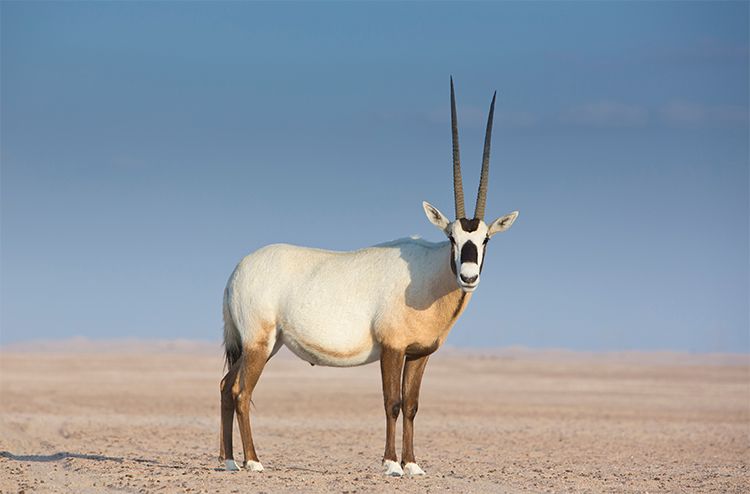
The dramatic recovery of the oryx, driven almost to extinction across the Arabian Peninsula, has inspired conservationists working to see the leopard returned to the wild in Saudi Arabia. (Shutterstock)
“If you want to understand where we're trying to go with the Arabian leopard initiative, just look at what conservationists have already achieved in the Arabian Peninsula,” he said.
“The recovery of the Arabian oryx has turned out to be one of the most inspirational case studies for captive breeding and reintroduction of any species anywhere in the world, and one of the most powerful models we have for the successful reintroduction of the Arabian leopard itself.
“Everyone involved in that program remembers when the first Arabian oryx was born in captivity. They had no idea that it was going to be as successful as it was. But we certainly do believe that with the births of the cubs that we’re seeing in Taif, we are seeing the first paw prints of the success of the Arabian leopard initiative.”
By 1972 Oryx leucoryx, a species of antelope once common across the Arabian Peninsula and known in Arabic as Al-Maha, had been hunted to extinction in the wild.
After being bred from captive specimens, by 1982 the species had been reintroduced into the wild in Oman, and subsequently in Saudi Arabia and the UAE. By 2011 the status of the species on the IUCN Red List had changed from extinct to vulnerable — the first time that a vanished species had made such a dramatic comeback.
Now, conservationists are on course to bring the Arabian leopard back from the brink in similarly spectacular fashion.
Over the past few years, researchers armed with camera traps have tried in vain to capture evidence of leopards in the wild in Saudi Arabia, but proof that the animals thrived there for thousands of years can be found in ancient rock carvings, or petroglyphs, scattered across the landscape.
In 2001 a local schoolteacher stumbled across hundreds of the petroglyphs on an escarpment overlooking a sand-covered wadi in a remote area about 40km west of the village of Shuwaymis in the Hail region of Saudi Arabia.
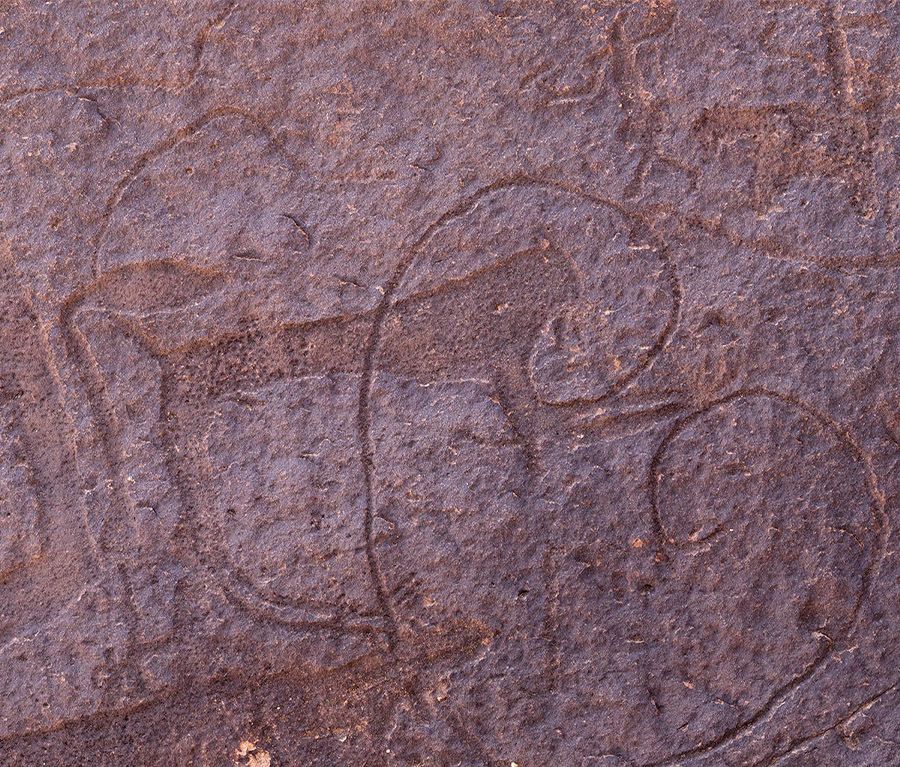
A petroglyph of a leopard, carved into a rock at Shuwaymis, Saudi Arabia, thousands of years ago. (Richard Bryant)
A petroglyph of a leopard, carved into a rock at Shuwaymis, Saudi Arabia, thousands of years ago. (Richard Bryant)
It was a historic find and in 2015 the site was inscribed on UNESCO’s World Heritage List as part of the biggest and most significant collection of rock art in Saudi Arabia and the wider region.
There, among hundreds of illustrations of wildlife dating back as far as 10,000 years, were clear depictions of leopards, lions and cheetahs prowling what was at the time the verdant landscape of the Arabian Peninsula.
Such proof of the leopard’s long reign in Arabia also provides evidence of the abundance of many other species of wildlife that thrived in ancient times. Before the lakes and rivers dried up and the lush savannas of central Arabia were transformed into the deserts that cover much of the interior today, the land teemed with abundant prey, including gazelles, ibex, oryx and onager, a type of wild ass.
In 2013, researchers with the Palaeodeserts Project, a collaboration between the University of Oxford and the Saudi Commission for Tourism and National Heritage, mapped and analyzed many of the rock-art panels at Shuwaymis.
They concluded that feeding a typical pride of about 13 lions would have required a herd of more than 160 onager, to allow the prey to breed and maintain its numbers. More than 70 mountain gazelles, they concluded, would have been necessary for the sustainable support of a single leopard.
As the rock art attests, Arabia’s big cats were still present in large numbers up until about 2,000 years ago — but time was running out for the lion, the cheetah and the leopard.

On the left side of this frieze from Yemen, created between the 5th and 3rd centuries BC, a lion attacks a gazelle, while on the right a leopard jumps onto the back of an ibex. (Walters Art Museum)
On the left side of this frieze from Yemen, created between the 5th and 3rd centuries BC, a lion attacks a gazelle, while on the right a leopard jumps onto the back of an ibex. (Walters Art Museum)
The Asiatic lion, panthera leo leo, is long gone from the Arabian peninsula and can only be found now in the Indian state of Gujarat. Once common throughout Arabia and Mesopotamia, in Saudi Arabia it had been hunted to extinction by the late 19th century.
Two of the last-known lions on record in the wider region were shot in 1914 by an Ottoman official near Mosul. Poignantly, they were killed close to the ancient city of Nineveh, where reliefs carved more than 2,500 years ago depict lions being hunted by King Ashurbanipal, who ruled the Assyrian empire from 668 B.C. until 631 B.C.
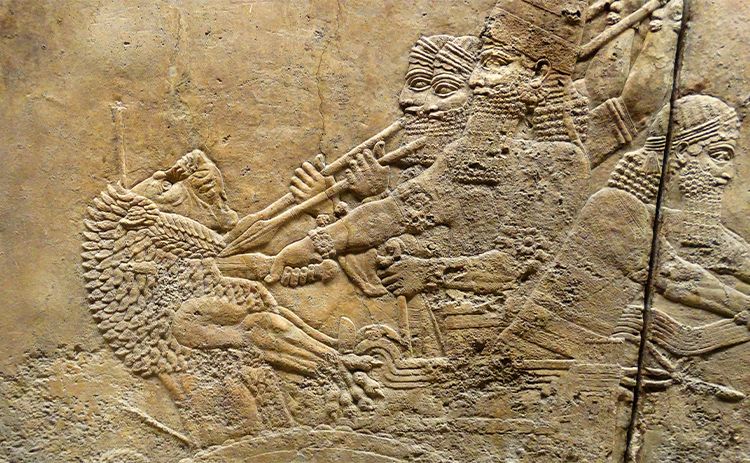
A wall panel relief from the Assyrian capital of Nineveh, near Mosul in Iraq, depicting King Ashurbanipal hunting a lion from his chariot in about 645-635 BC. (Getty Images)
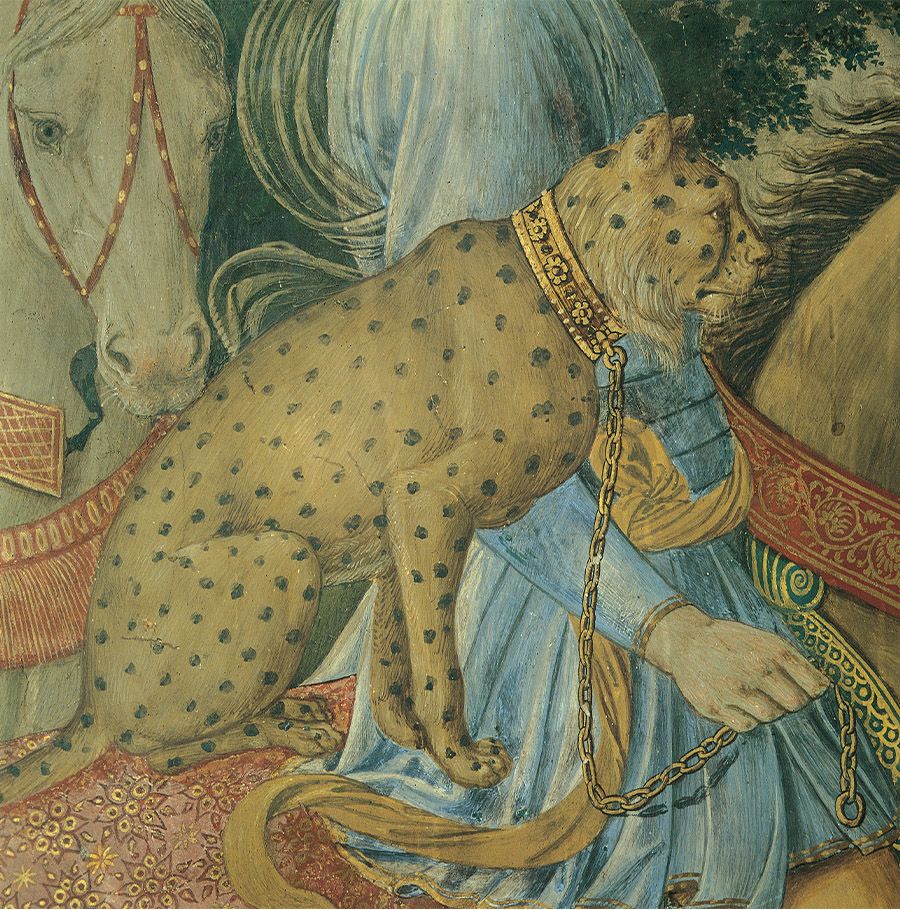
The cheetah, prized as an exotic trophy for centuries and adopted as the symbol of the Florentine house of Lucca, appears in this 15th-century panel in the Magi Chapel in Florence, Italy, depicting the three wise men traveling to Bethlehem. (Getty)
The cheetah, prized as an exotic trophy for centuries and adopted as the symbol of the Florentine house of Lucca, appears in this 15th-century panel in the Magi Chapel in Florence, Italy, depicting the three wise men traveling to Bethlehem. (Getty)
The cheetah, Acinonyx jubatus, managed to survive a little longer in the region but now it, too, is no more in the wild, driven to extinction across the Arabian peninsula in living memory by uncontrolled hunting of the animal and its prey. Its fate serves to motivate those now charged with bringing the leopard back from the brink.
There are records of cheetahs in Saudi Arabia and Kuwait until at least the late 1950s. In 1959 it was reported that four of the animals were killed in northern Saudi Arabia, close to the borders with Iraq and Jordan.
A solitary cheetah was spotted in Wadi Mitan in eastern Yemen, close to the border with Oman, in 1963. Another was reportedly shot dead near Jibjat in southern Oman in 1977. This remains the last known sighting of the animal in the Arabian Peninsula.
The Arabian leopard, panthera pardus nimr, proved to be a little more resilient
It adapted successfully over thousands of years to the changing climate and increasingly arid conditions of Saudi Arabia, surviving the great desertification process that by 2,000 years ago was complete across Arabia.
In the end, however, like the lion and the cheetah before it, the leopard was unable to adapt to the evolution and expansion of the ultimate apex predator species: homo sapiens.
Historically, the Arabian leopard ranged over a large area of Saudi Arabia. Its heartland was in the mountains that border the Red Sea coast, from Jordan in the north to Yemen in the south, but it could also be found further east, as testified by the rock carvings in the Hail region.
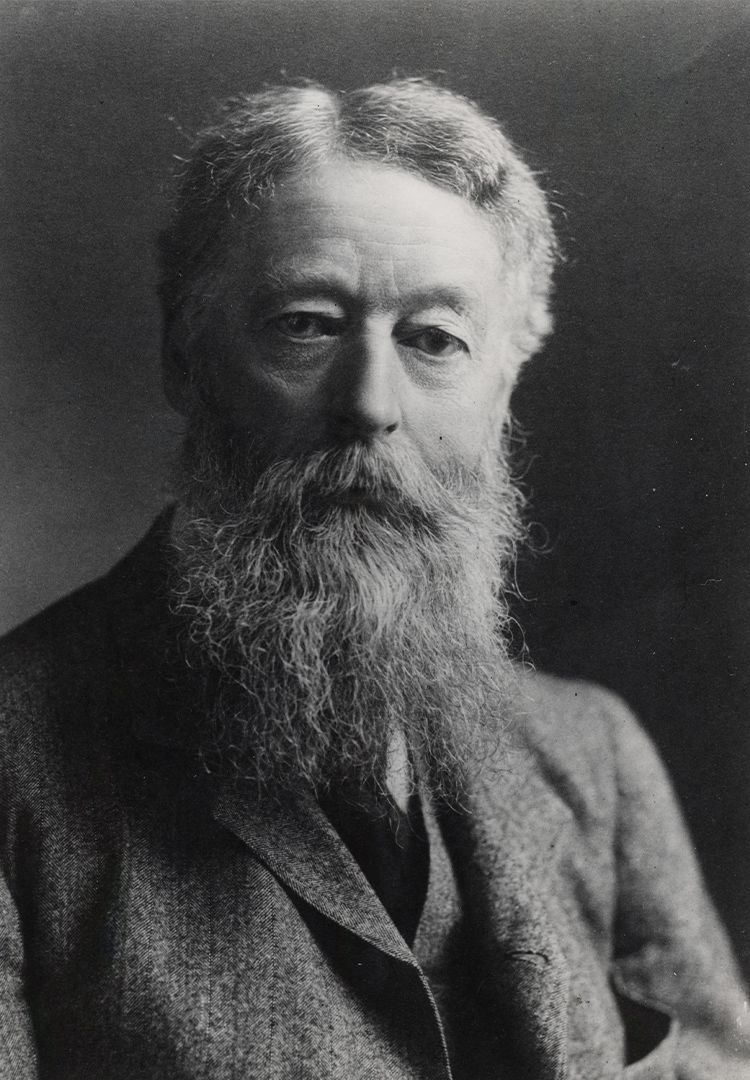
In 1888 the British explorer Charles Doughty wrote of encountering animals in Saudi Arabia including hyena and "the nimr, a leopard, brindled black and brown and spotted.” (Getty Images)

The English adventurer Lady Anne Blunt traveled to the heart of Arabia to buy Arabian horses, and encountered leopards in the Nefud desert. (Alamy)
The English adventurer Lady Anne Blunt traveled to the heart of Arabia to buy Arabian horses, and encountered leopards in the Nefud desert. (Alamy)
According to accounts by early Western travelers, including English explorers Lady Anne Blunt and Charles Doughty, in the late 19th century the leopard could still be found far inland, as far east as the provinces of Hail and Riyadh.
In her 1881 book, “A Pilgrimage to Nejd,” Lady Anne wrote: “Of wild animals, I have ascertained the existence of the ostrich, the leopard, the wolf, the fox, the hyena, the hare, the jerboa, the white antelope, and the gazelle in the Nefud.” The Nefud is the great desert in the Hail region of northern Saudi Arabia.
In “Travels in Arabia Deserta,” published in 1888, Doughty reported that “of the great predatory animals, most common is the thubba, hyena; then the nimr, a leopard, brindled black and brown and spotted.”
In centuries past, as many as four sub-species of leopard might have roamed the Arabian Peninsula. Only one, Panthera pardus nimr, the Arabian leopard, remains — only just, and perhaps not at all in Saudi Arabia.
Reported sightings of the animal in the Kingdom were already rare by the 1960s. Of 19 sightings documented by researchers between 1998 and 2003, only four are considered confirmed.
At Jibal Shada in 1999, a dead goat was discovered that bore all the hallmarks of having been attacked and partially eaten by a leopard. At Al-Atifa that same year, and at Wadi Khatayn in 2002, tracks and other tell-tale signs of leopard activity were identified.
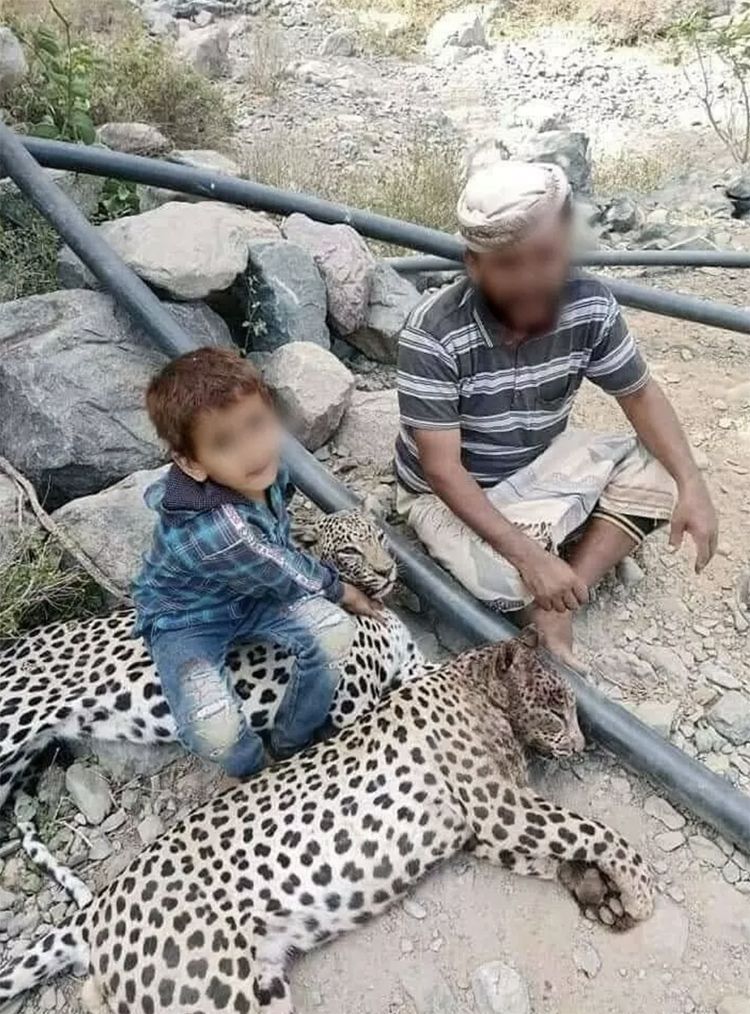
These two leopards were shot by a farmer in Lawdar, southern Yemen, in July 2021.
In July 2021 international outrage followed the circulation of photographs on social media of two leopards that had been shot dead in Lawdar, southern Yemen. The man, a farmer, claimed the animals had been killing his sheep. Although killing the animals is illegal in Yemen, officials admitted that bringing the man to justice in the war-torn country would be difficult. "Unfortunately," a spokesman for the Environmental Protection Authority told the media, "the protection of animals just isn’t a priority considering the chaos in the region at the moment."
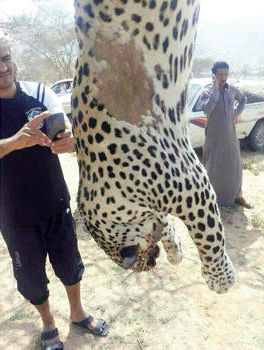
The last known sighting of a leopard in Saudi Arabia, poisoned by a shepherd in Bawadi Al-Numan village, Makkah, in 2014.
The last known sighting of a leopard in Saudi Arabia, poisoned by a shepherd in Bawadi Al-Numan village, Makkah, in 2014.
The most recent confirmed sighting in the Kingdom was another unhappy one. Just when it seemed the leopard might have vanished forever from Saudi Arabia, a video of a dead animal was posted on YouTube in 2014. It had been killed unintentionally in the Wadi Numan area of Makkah by a farmer who had put out poison to kill wild dogs that were attacking his livestock.
“No one has the right to poison any animal, endangered or otherwise," said Ahmed Al-Bouq, general manager of the National Wildlife Commission at the time. “People should contact us or any other authority and we will take the necessary measures to protect both sides.”
Since then, the leopard has not been seen in the Kingdom, dead or alive, despite determined efforts to capture evidence of the animal on camera.
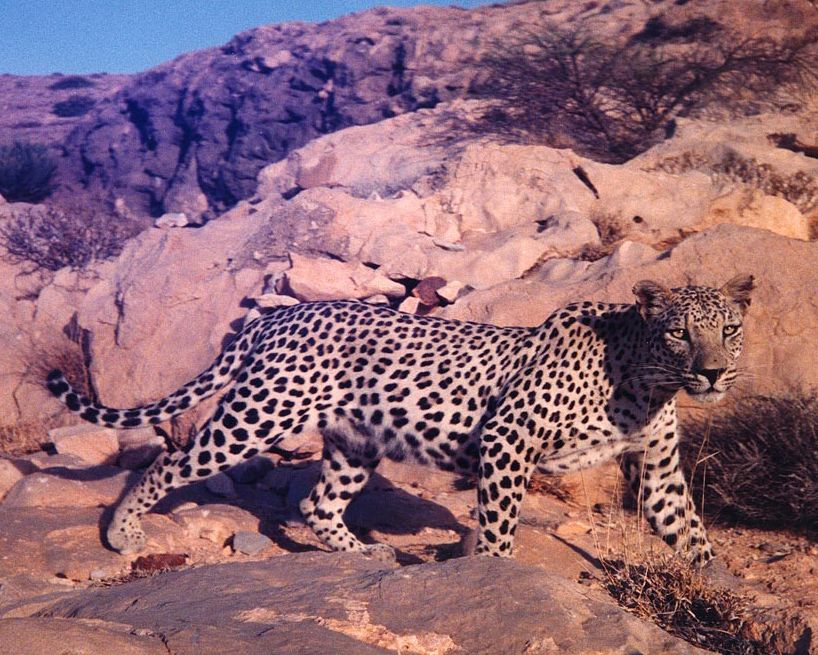
The last stronghold of the leopard in Arabia is believed to be in Oman's Dhofar Mountains, where the animals have been photographed by camera traps. (Land Rover Our Planet)
The last stronghold of the leopard in Arabia is believed to be in Oman's Dhofar Mountains, where the animals have been photographed by camera traps. (Land Rover Our Planet)
“I don’t think we can say for certain that the leopard is extinct in Saudi Arabia,” said biologist David Mallon, a visiting professor in the Department of Natural Sciences at Manchester Metropolitan University and a member of the IUCN Red List Committee.
“But over the past few years a lot of camera trapping has been carried out. This has been much intensified by the Panthera people, working with AlUla at a dozen sites over the past two years, but they haven’t found any photographs of the leopard.
“So the feeling at the moment is that it is almost certain that there are no extant populations, although there could still be the odd animal or two hanging on somewhere.”
There are, he said, a host of reasons to ensure the leopard does not disappear for ever, “whether it’s aesthetics, the moral issue — that we inherited this, therefore we should pass it on to future generations — or whether it’s about the overall health of the ecosystem.
“Because if you want to have fully functioning, natural, dynamic ecosystems, you need all the levels in the food chain present, and the apex predator is the one that regulates the next ones down, and so on.
“Each animal contributes to an ecosystem and as soon as you disrupt that system in some way you can’t predict how the services it provides may also be disrupted.”
Mallon, who in 2011 co-compiled the IUCN Red List assessment of carnivores in the Arabian Peninsula, has since completed a regional assessment of all the mammals of the Peninsula, which has yet to be published.
Overall, he said, “the story isn’t entirely bleak. For the four large carnivores the picture remains terrible: the cheetah is extinct and the leopard, the wolf and the hyena are all in big trouble.”
But for the ungulates — hoofed mammals such as the oryx, mountain gazelle, sand gazelle and Ibex — “the picture is not quite so bad. There is a big improvement for the oryx and the two gazelles, with thousands now across the peninsula, and although listed still as vulnerable there are now quite a few ibex here and there.”
In addition to the carnivores and these other large mammals, there are medium and small mammals, including three types of fox, “which to a large extent are data-deficient because not enough people study them,” Mallon said.
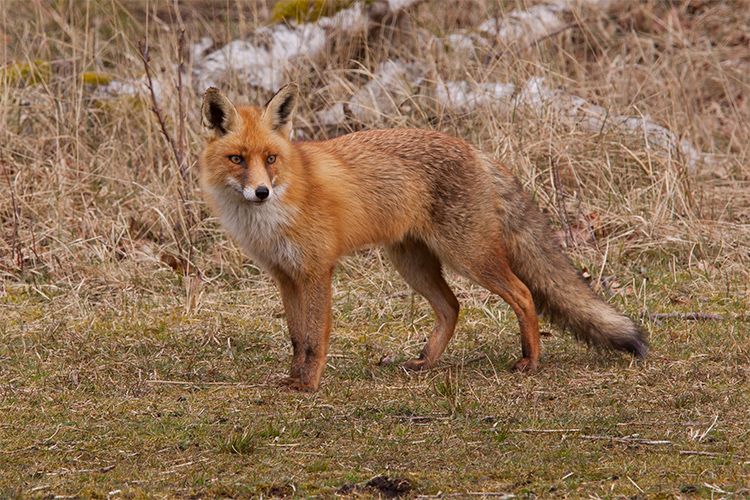
Saudi Arabia's diverse wildlife includes the red fox (above), Rüppell's fox, caracal, Arabian wolf and striped hyena. (Shutterstock)
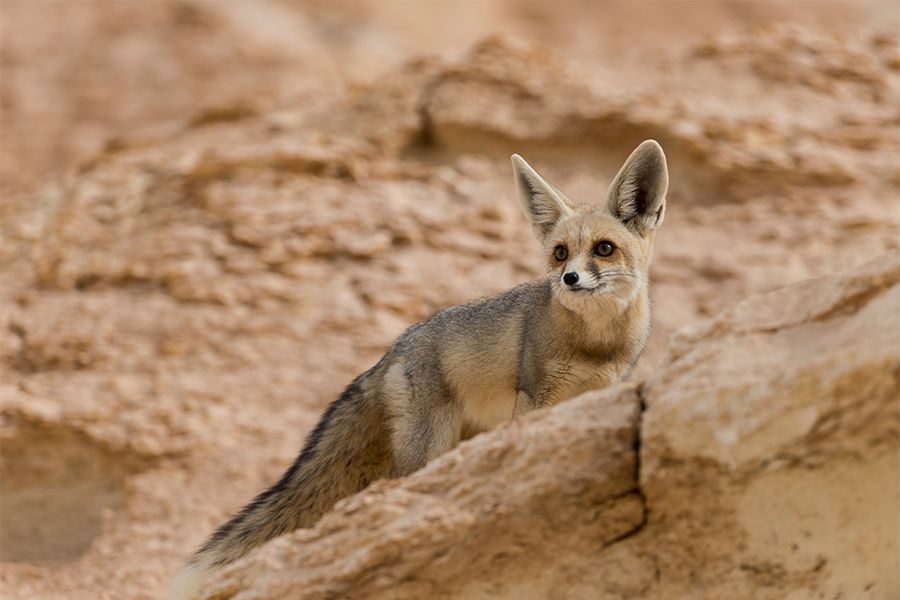
Saudi Arabia's diverse wildlife includes the red fox, Rüppell's fox (above), caracal, Arabian wolf and striped hyena. (Shutterstock)
What is known, however, is that attempting to understand and balance ecosystems is a complex business. For example, the success of the common, and highly adaptable, red fox — which is thriving everywhere, from cities in England to the deserts of Arabia — might be marginalizing the smaller Ruppell’s fox, which in Saudi Arabia is increasingly retreating to the hyper-arid regions to which it is better suited than its rival.
In another demonstration of the fragile balance of ecosystems, the caracal population seems to be increasing in Saudi Arabia. On the face of it, this seems like good news, but it is happening as a result of a problematic phenomenon known as “mesopredator release.”
“Once the big predators, such as the leopards and cheetahs, go, the medium-sized predators can expand because they’re not being preyed upon any more,” said Mallon.
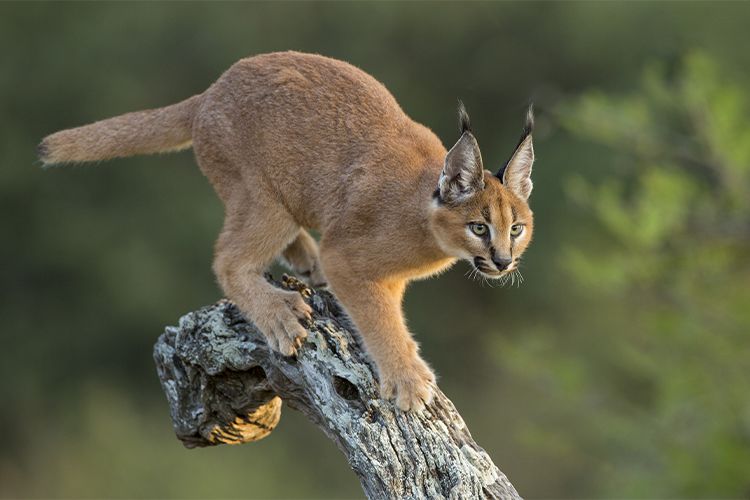
Saudi Arabia's diverse wildlife includes the red fox, Rüppell's fox, caracal (above), Arabian wolf and striped hyena. (Shutterstock)
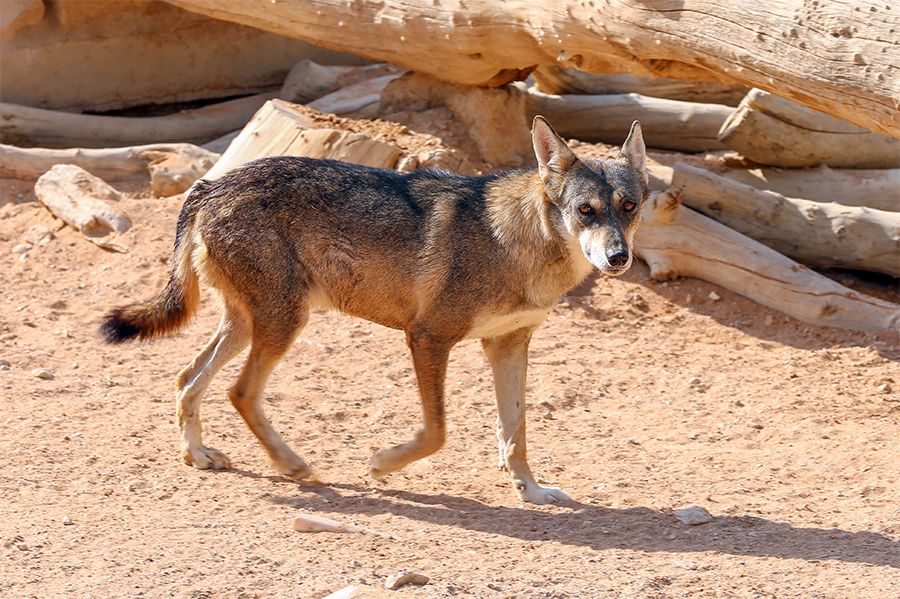
Saudi Arabia's diverse wildlife includes the red fox, Rüppell's fox, caracal, Arabian wolf (above) and striped hyena. (Shutterstock)
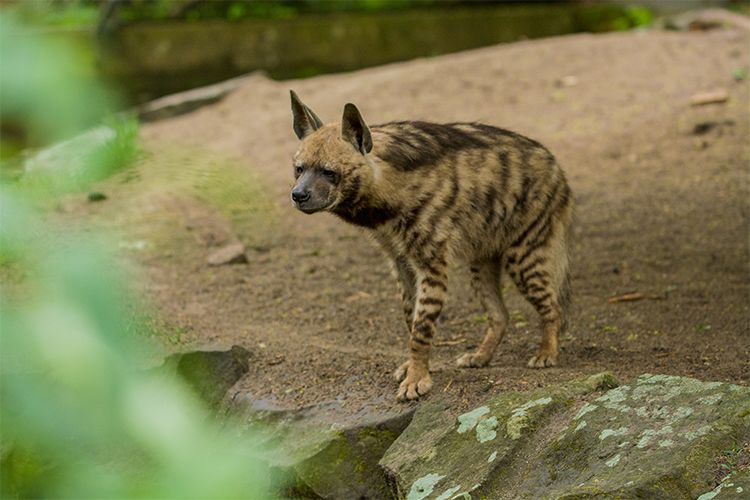
Saudi Arabia's diverse wildlife includes the red fox, Rüppell's fox, caracal, Arabian wolf and striped hyena (above). (Shutterstock)
“So the caracal is possibly benefiting from the fewer numbers of leopards, and the foxes are possibly benefiting from fewer wolves and hyenas.”
When this happens, ultimately no one benefits.
“If you lose an animal such as the leopard, it means your natural environment has lost something which has evolved over hundreds of thousands of years, and so you’ve lost a part of your own natural heritage,” said Mallon.
Certainly, said Al-Malki, the RCU’s head of nature reserves, the Arabian leopard “is an iconic species for us and very important in Arab culture.” This alone makes it “essential to preserve it as one of the most important wild species in Saudi Arabia,” he added.
The breeding program being overseen by the RCU at the Prince Saud Al-Faisal Wildlife Research Center in Taif, which was originally managed by the National Center for Wildlife, will ultimately be transferred to a new Arabian Leopard Center being built as part of the Sharaan Nature Reserve, the protected habitat, covering 925 sq km, where eventually the leopards will be released.
It is, said Al-Malki, entirely fitting that the leopard’s return will begin in AlUla, which was carefully chosen as the ideal location after an extensive survey of the area.
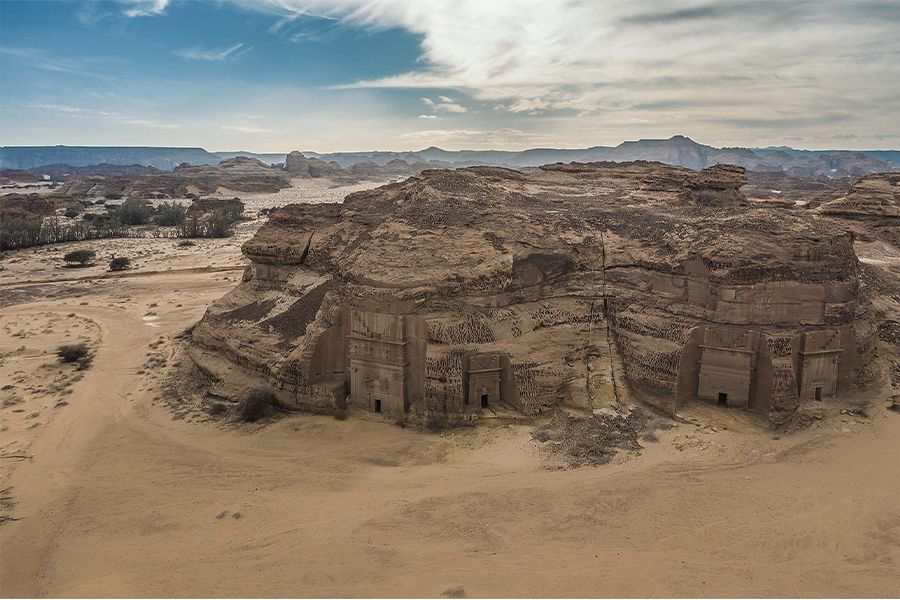
The dramatic sandstone landscapes of AlUla were home to the Arabian leopard for thousands of years, and soon will be again. (RCU)
The dramatic sandstone landscapes of AlUla were home to the Arabian leopard for thousands of years, and soon will be again. (RCU)
“The Arabian leopard was present in this area previously, and most areas of AlUla,” he said. “The ecosystem in this area has begun to recover in a very large way. Moreover, in cooperation with our partners at the National Center for Wildlife, we have re-released some important wild species that will be potential prey for the Arabian leopard in the future.”
Once the leopards have been successfully reestablished in the Sharaan reserve, there are plans to reintroduce them to other parts of AlUla, followed by other areas of the country where they were once common, including the Asir, Hijaz and Midian mountain ranges in the west of the country
Panthera is performing a crucial partnership role to help the RCU achieve this vision.

Partners: Prince Badr Al-Saud, Governor of the Royal Commission for AlUla, signed an agreement with Thomas Kaplan of big-cat conservation organization Panthera in the heart of AlUla in June 2019. (RCU)
Partners: Prince Badr Al-Saud, Governor of the Royal Commission for AlUla, signed an agreement with Thomas Kaplan of big-cat conservation organization Panthera in the heart of AlUla in June 2019. (RCU)
In June 2016, during an open-air ceremony amid the stunning scenery of AlUla, Prince Badr bin Abdullah Al-Saud, the Saudi minister of culture and governor of the RCU, signed an agreement with Panthera chairman Kaplan in which the commission pledged to invest $20 million over 10 years to aid global conservation efforts for leopards and revitalize the Arabian leopard population.
Saudi Arabia is also now a member of The Global Alliance for Wild Cats, an international coalition of environmental philanthropists, founded by Kaplan and dedicated to protecting the world’s big cats.
Formed in 2014 by Mohammed Bin Zayed Al-Nahyan, the Crown Prince of Abu Dhabi, in addition to representatives of the UAE and Saudi Arabia the alliance now also includes members from China, India and the US, who have each pledged $20 million as the cornerstone of a $200 million global campaign to save wild cats.
After the 2016 ceremony, Prince Badr said the partnership represents “a major milestone in our shared ambitions to reintroduce the Arabian leopard population in the region and join global partners to support the preservation of these wild-cat populations worldwide.”
It is, he added, “our duty to protect, conserve and build the population numbers to preserve the species from becoming a footnote of history.”
The RCU partnership with Panthera “will help ensure that populations in other countries around the world are preserved before they reach the levels of endangerment faced today by our precious native big cats,” the prince said.
To this end, in 2019 the RCU established the Global Fund for the Arabian Leopard. With an initial endowment of $25 million it is the largest fund in the world wholly dedicated to safeguarding the species.
The Arabian leopard is the smallest of nine sub-species of leopard. Once widely distributed across Africa and Asia, populations everywhere are shrinking as a result of threats including encroachment by humans, diminishing habitat and prey, the illegal trade in wildlife, and hunting in response to the demand for ceremonial use of skins.
Globally, the leopard is classified as “vulnerable” on the IUCN’s Red List, with its numbers in decline. In Arabia, however, is it deemed to be “critically endangered,” two steps worse off than elsewhere in the world.
Other carnivorous mammals in Saudi Arabia, including the caracal, sand cat and golden jackal, are also rated as vulnerable to one degree or another, but are expected to benefit from the renewed focus on protecting landscapes and crucial habitats.

"Forging a greener world" – Saudi Crown Prince Mohammed bin Salman at the launch of the Saudi Green Initiative in Riyadh in October 2021. (AFP/Saudi Royal Palace)
"Forging a greener world" – Saudi Crown Prince Mohammed bin Salman at the launch of the Saudi Green Initiative in Riyadh in October 2021. (AFP/Saudi Royal Palace)

The dramatic recovery of the oryx, driven almost to extinction across the Arabian Peninsula, has inspired conservationists working to see the leopard returned to the wild in Saudi Arabia. (Shutterstock)
The dramatic recovery of the oryx, driven almost to extinction across the Arabian Peninsula, has inspired conservationists working to see the leopard returned to the wild in Saudi Arabia. (Shutterstock)

A wall panel relief from the Assyrian capital of Nineveh, near Mosul in Iraq, depicting King Ashurbanipal hunting a lion from his chariot in about 645-635 BC. (Getty Images)
A wall panel relief from the Assyrian capital of Nineveh, near Mosul in Iraq, depicting King Ashurbanipal hunting a lion from his chariot in about 645-635 BC. (Getty Images)

In 1888 the British explorer Charles Doughty wrote of encountering animals in Saudi Arabia including hyena and "the nimr, a leopard, brindled black and brown and spotted.” (Getty Images)
In 1888 the British explorer Charles Doughty wrote of encountering animals in Saudi Arabia including hyena and "the nimr, a leopard, brindled black and brown and spotted.” (Getty Images)

These two leopards were shot by a farmer in Lawdar, southern Yemen, in July 2021.
These two leopards were shot by a farmer in Lawdar, southern Yemen, in July 2021.

Saudi Arabia's diverse wildlife includes the red fox (above), Rüppell's fox, caracal, Arabian wolf and striped hyena. (Shutterstock)
Saudi Arabia's diverse wildlife includes the red fox (above), Rüppell's fox, caracal, Arabian wolf and striped hyena. (Shutterstock)

Saudi Arabia's diverse wildlife includes the red fox, Rüppell's fox (above), caracal, Arabian wolf and striped hyena. (Shutterstock)
Saudi Arabia's diverse wildlife includes the red fox, Rüppell's fox (above), caracal, Arabian wolf and striped hyena. (Shutterstock)

Saudi Arabia's diverse wildlife includes the red fox, Rüppell's fox, caracal (above), Arabian wolf and striped hyena. (Shutterstock)
Saudi Arabia's diverse wildlife includes the red fox, Rüppell's fox, caracal (above), Arabian wolf and striped hyena. (Shutterstock)

Saudi Arabia's diverse wildlife includes the red fox, Rüppell's fox, caracal, Arabian wolf (above) and striped hyena. (Shutterstock)
Saudi Arabia's diverse wildlife includes the red fox, Rüppell's fox, caracal, Arabian wolf (above) and striped hyena. (Shutterstock)

Saudi Arabia's diverse wildlife includes the red fox, Rüppell's fox, caracal, Arabian wolf and striped hyena (above). (Shutterstock)
Saudi Arabia's diverse wildlife includes the red fox, Rüppell's fox, caracal, Arabian wolf and striped hyena (above). (Shutterstock)
In Saudi Arabia, Panthera researchers continue to work in the field in an attempt to determine exactly what, if anything, remains of the wild leopard population in the Kingdom and identify the greatest threats to its existence. They are also establishing the “carrying capacity” of the proposed Sharaan Nature Reserve, which means the number of leopards the protected area will be able to support.
“By establishing a long-term monitoring, conservation and breeding program for the Arabian leopard, including the successful reintroduction of leopards and their prey to Al-Sharaan Nature Reserve in AlUla, we will be able to accomplish saving the species in Saudi Arabia as well as in all the areas of its previous range, which include not just existing populations in Yemen and Oman but also the United Arab Emirates, Jordan and even Israel,” said Kaplan.
Working with the animals, however, is only part of the challenge.
“It’s fair to say that about 80 percent of the work that wildlife conservationists do is with people, not just the animals,” Kaplan explained.
“Most important in the process of reintroducing big cats is to ensure the buy-in of local populations and one of the areas that we will be focusing on is to prepare the local communities for the re-emergence of the leopard.”
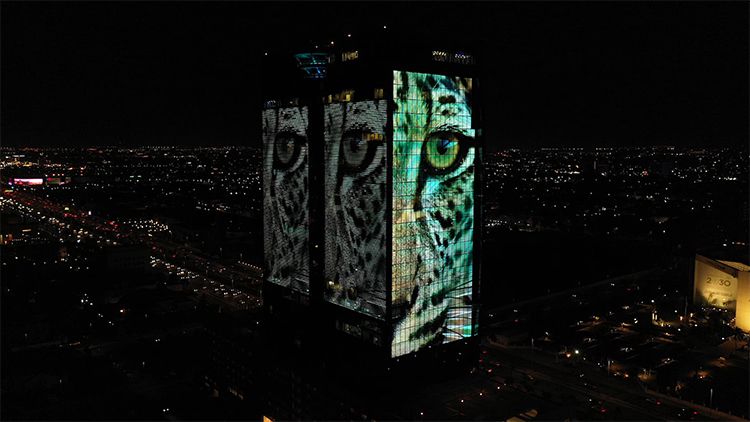
During the first Arabian Leopard Day, staged on Feb. 10, 2022, images of the animal lit up major buildings and sites including the King's Road Tower in Jeddah, the Burj Khalifa in Dubai and Elephant Rock in AlUla.
To achieve this, the RCU has launched an awareness program that got under way on Feb. 10 with the inaugural Arabian Leopard Day, during which landmarks across the region were lit up and a competition was launched to name the latest cub born in the program.
The Arabian leopard, said Kaplan, “is not a particularly dangerous animal to humans. Like most big cats, it’s much more afraid of humans than the other way around. They want to keep a safe distance, they want to be able to protect their cubs. That means avoiding those creatures with whom they are not particularly conversant as a species, and human beings fall into that category.”
Nevertheless, inevitably there will be times when the paths of animals and humans cross.
“Most of the time, those instances will be entirely benign,” said Kaplan. “On occasion you will find that leopards will take livestock — the leopard is not very familiar with the concept of private property, or able to distinguish between that which is domesticated and that which is wild.
“So what we have to do is to make sure that the local communities who live with these animals are supported as much as the wildlife itself, and that they understand that there is a solution if there is a problem.”
That solution is to guarantee that farmers will be compensated for any livestock lost to leopards, so long as they do not kill or harm the wild cats. “In other words, they have to be able to see that there is no downside to the leopard coming back into their habitat,” said Kaplan.
Panthera will also help communities to realize that “there is a direct link between their prosperity, their future, and the fact that the leopard is being reintroduced,” he added.
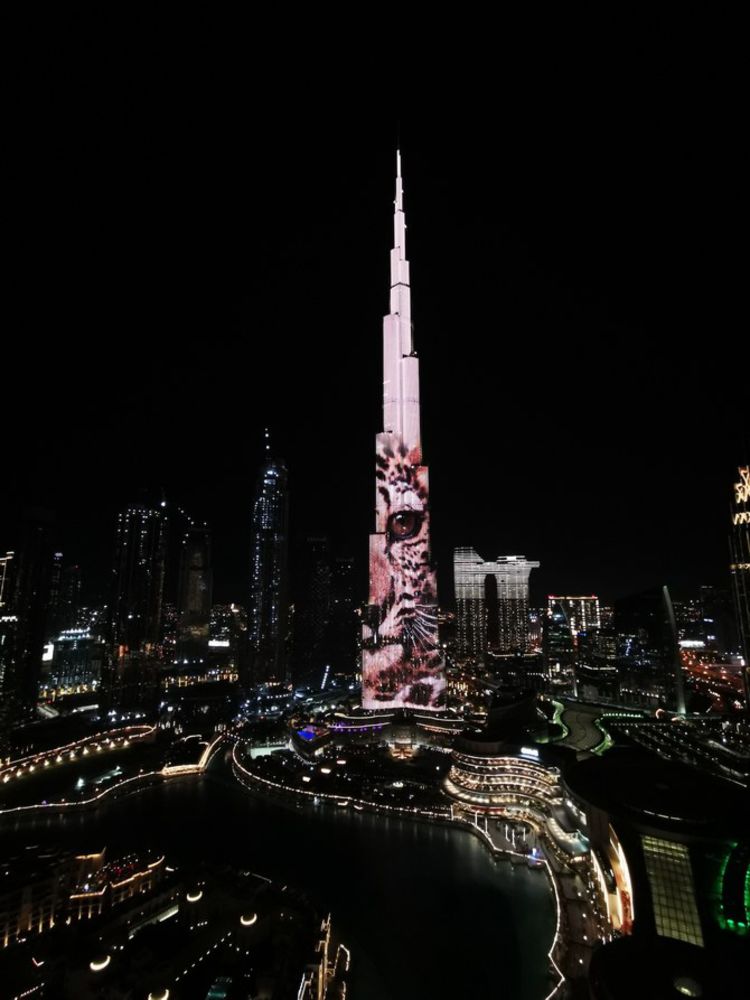
During the first Arabian Leopard Day, staged on Feb. 10, 2022, images of the animal lit up major buildings and sites including the King's Road Tower in Jeddah, the Burj Khalifa in Dubai and Elephant Rock in AlUla.
The opportunity to see leopards once again thriving in the wild will doubtless play a significant part in the development of AlUla region as a cultural tourism destination rich in archaeology, heritage and stunning landscapes. This will also create jobs for local people. The RCU said it is “working hand-in-hand with the local community” and investing in “education and learning for AlUla’s next generation, to create training and employment opportunities.”
Panthera has had some experience of this. As part of a project to reintroduce the jaguar to the Pantanal region of Brazil, the organization bought ranches that connected national parks in the area and helped to improve the lives of the ranchers.
“We took them from living in dormitories and gave them individual homes so that their families, who used to have to live off the ranch, could now live with them on the ranch,” said Kaplan.
“More than that, we brought in doctors from Mount Sinai Medical Center who, as part of their residency, provided medical care to the communities that were not receiving the standard of care that they would have received in more urban areas.
“Most importantly, perhaps, we created schools. In other words, we were able to show the local communities that there was a direct link between our being there to conserve cats, and the fact that these people would have a better life for their kids, both educationally and health-wise, because of the conservation efforts.
“Our intention is to do the same in Saudi Arabia in the vicinity of the Arabian leopard initiative program.”
Legislation will also play a part in protecting the animals. The penalty for hunting leopards in Saudi Arabia is SR 400,000 ($107,000), rising to SR 30 million for repeat offenses, and up to 10 years in prison. But ultimately, the most effective form of protection is winning the hearts and minds of local communities.
Such has been the success of the program in Brazil, Kaplan said, “we have a joke: We can’t always ensure that a poacher doesn’t get in but because the local community sees the Jaguar as being part of its future, the poacher rarely gets out. And that’s good enough for us.”
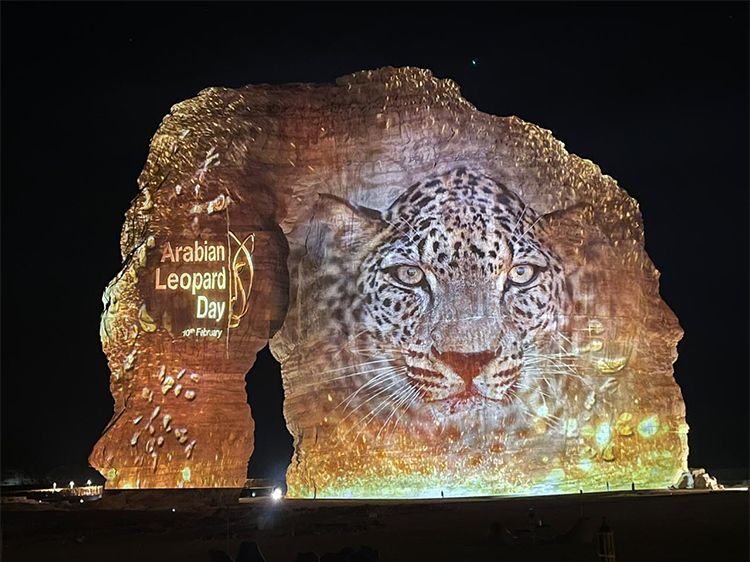
During the first Arabian Leopard Day, staged on Feb. 10, 2022, images of the animal lit up major buildings and sites including the King's Road Tower in Jeddah, the Burj Khalifa in Dubai and Elephant Rock in AlUla.
Leopards will not be seen roaming the majestic landscape of AlUla quite yet, however. “We expect the first program to resettle leopards in Sharaan Nature Reserve by 2030,” said Al-Malki.
If this target is met, the timing would be perfect; the AlUla project in its entirety — opening it up as a global tourism destination rich in natural and human history — is one of the cornerstones of the Kingdom’s Vision 2030 blueprint for economic diversification, empowerment of local communities and the preservation of the nation’s heritage.
“Suffice to say,” said Kaplan, “we’re very confident that we will be able to reintroduce the leopards to their maximum carrying capacity and to that end we are already engaged in the restoration of habitat which has endured decades of overgrazing and other development issues.
“We’re also working with the local communities and working to restore the populations of ibex and gazelle that we need to be able to fully sustain the food cycle for the Arabian leopard itself.
“In the same way as the cultural restoration that’s taking place at AlUla is going to take a number of years, the environmental restoration is going to be an equally long process.”
He added: “There really are no shortcuts when it comes to captive breeding and reintroduction. You have to do it right and you have to do it right from the outset. What we can say for sure is that the Kingdom is doing it right.”

During the first Arabian Leopard Day, staged on Feb. 10, 2022, images of the animal lit up major buildings and sites including the King's Road Tower in Jeddah, the Burj Khalifa in Dubai and Elephant Rock in AlUla.
During the first Arabian Leopard Day, staged on Feb. 10, 2022, images of the animal lit up major buildings and sites including the King's Road Tower in Jeddah, the Burj Khalifa in Dubai and Elephant Rock in AlUla.

During the first Arabian Leopard Day, staged on Feb. 10, 2022, images of the animal lit up major buildings and sites including the King's Road Tower in Jeddah, the Burj Khalifa in Dubai and Elephant Rock in AlUla.
During the first Arabian Leopard Day, staged on Feb. 10, 2022, images of the animal lit up major buildings and sites including the King's Road Tower in Jeddah, the Burj Khalifa in Dubai and Elephant Rock in AlUla.

During the first Arabian Leopard Day, staged on Feb. 10, 2022, images of the animal lit up major buildings and sites including the King's Road Tower in Jeddah, the Burj Khalifa in Dubai and Elephant Rock in AlUla.
During the first Arabian Leopard Day, staged on Feb. 10, 2022, images of the animal lit up major buildings and sites including the King's Road Tower in Jeddah, the Burj Khalifa in Dubai and Elephant Rock in AlUla.
Credits
Writing and research: Jonathan Gornall, Lama Alhamawi
Editor: Tarek Ali Ahmad
Creative director: Simon Khalil
Designer: Omar Nashashibi
Graphics: Douglas Okasaki, Waleed Rabin
Video producer: Mohammed Qenan
Videographers: Abdullah Aljaber, Mohammed Alqahwi
Video editor: Ali Noori
Picture researcher: Sheila Mayo
Copy editor: Liam Cairney
French editor: Zeina Zbibo
Social media: Jad Bitar, Daniel Fountain
Producer: Arkan Aladnani
Editor-in-Chief: Faisal J. Abbas
